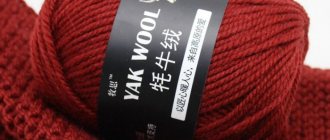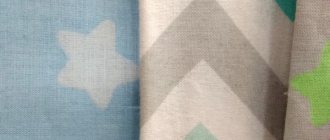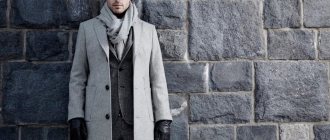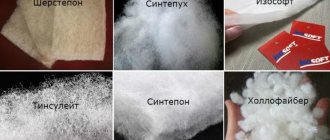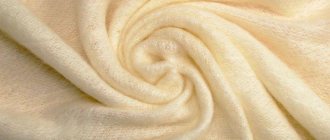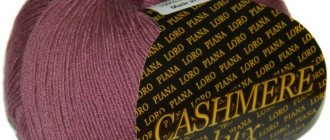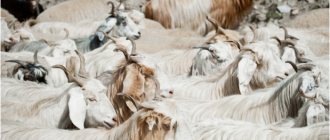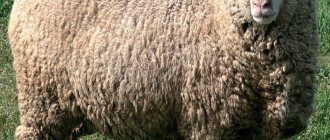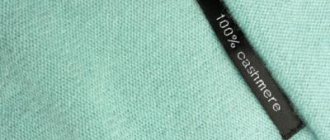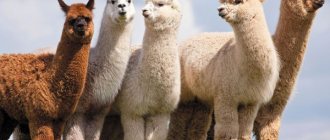History of cashmere
Thin, lightweight shawls made from the down of Tibetan mountain goats began to be produced in the 12th century in the Kashmir province in India, which later gave its name to the famous woolen material.
In Europe, people started talking about cashmere in the 18th century thanks to Emperor Napoleon Bonaparte, who brought a light embroidered shawl - pashmina - as a gift to Josephine. The fabric captivated European aristocrats, became an indispensable attribute of secular fashionistas and was valued on a par with family jewelry.
At the beginning of the 20th century, material appeared on the catwalks of several fashion houses and began its victorious march in the fashion world.
Properties of cashmere
Cashmere fabrics have healing properties.
Cashmere has amazing, at first glance, incompatible properties.
- The weight of light and airy cashmere fabric is only a few grams. A mountain goat down shawl can be easily pulled through a wedding ring.
- Cashmere fibers are much thinner than silk threads, so the fabric is much softer than silk.
- The low thermal conductivity of the fiber makes cashmere a surprisingly warm material.
- Cashmere fabric does not cause an allergic reaction, since dust mites do not grow in it.
- In terms of strength and wear resistance, cashmere is comparable to wool and silk.
- Pills on fabric form only in places of direct contact and after prolonged constant wear.
In addition, cashmere yarn and fabric have healing properties. It heals the diseased spine and joints. The natural wax contained in the fibers has a beneficial effect on the skin, gently caring for it.
How it is produced
Cashmere fabric is produced by twill weaving from long fibers of combed yarn. The raw material is the downy undercoat of mountain goats that live in the highlands of Mongolia, China, India, and Pakistan. The down is carefully processed and spun by hand, which is labor-intensive and time-consuming.
The main stages of the birth of cashmere:
- careful combing of animals in the spring;
- cleaning, sorting of raw materials;
- spinning wool fibers;
- yarn dyeing;
- creation of woven fabric.
The weight of fluff collected from one goat is 100-150 grams. To create 1 light woolen shawl, the down of 5 animals is used. To sew a thick cashmere coat, you need to comb 20-25 goats.
Twill weaving involves the intersection of warp and weft threads with a shift of 1 through 2 or 1 through 3. A characteristic pattern of diagonal lines is formed on the surface of the fabric.
Application
Cashmere is famous for its wide range of applications.
- The softness and safety of the material makes it suitable for creating textiles even for newborn children: numerous overalls, booties, socks, blankets will warm the baby and will not cause irritation to children's delicate skin.
- Warm casual clothes are made from cashmere: sweaters, turtlenecks, cardigans, jackets, dresses, skirts, trousers.
- Exquisite cashmere coats will add solidity and elegance to the owner.
- Hats, haberdashery: berets, hats, scarves, stoles, gloves, mittens - will keep you warm in bad weather and stylishly complement your look.
- Cashmere shawls are an eternal classic, an accessory that never goes out of style and has served as a symbol of luxury for centuries.
- Cashmere yarn is a high-quality durable thread for knitting exclusive handmade products. For ease of work and unsurpassed results, the optimal content of pure cashmere in yarn is 30-60%. It can be combined with merino and alpaca wool; Italian manufacturers often add silk.
Application of fabric
Cashmere sweaters are soft and warm.
Cashmere is a truly versatile fabric. Textiles for newborns and clothing for children and adults are made from it. Everyone knows coats, gloves and berets, skirts and cardigans made from this fabric.
Cashmere sweaters and dresses are especially popular, without which not a single famous Italian or Scottish brand can do. Eastern countries are still famous for their magnificent cashmere shawls and handmade carpets.
However, the cost of down products is quite high and depends on the thickness of the fiber and the original color of the raw material. Natural, undyed wool is white, grey, beige or black. White is the most valuable because after dyeing it it is easy to obtain pure colors.
Cashmere has a slight haze. To obtain a bright, rich color, silk or wool fibers are added to the fluff.
Description of the fabric: composition, properties, characteristics
Cashmere contains natural down from cashmere mountain goats. For brightness and color fastness, silk fibers are added to cashmere fabric, and viscose or polyester is added to reduce the cost of the finished fabric.
The material is amazingly soft, gives a pleasant sensation from contact with the skin, and does not prick. The fibers obtained from down are finer than human hair. It's hard to believe, but a cashmere shawl can easily be passed through a jewelry ring. The lightness of the fabric determines the airiness of things made from it: cashmere clothes seem to weigh nothing at all. At the same time, cashmere is a tear-resistant material, has low thermal conductivity, perfectly retains and enhances heat, and helps not freeze in cold weather.
CASHMERE COAT FABRICS
The cashmere presented on our shelf can definitely be classified as an elite fabric for sewing a first-class coat. Buy cashmere - soft, warm, natural, elastic, stylish and beautiful. Here is a small liver of the advantages of this wonderful fabric, which has special recognition among those who place high demands on coat fabrics.
The legend about cashmere tells about the origin of the fabric in the province of Kashmir, and about its amazing appearance in Europe thanks to Bonaparte Napoleon, who, according to the legend, brought a cashmere shawl to Josephine. However, these are all fairy tales, the real story is not known.
Initially, the undercoat of the Tibetan goat was used to make cashmere. Today, thanks to science, cashmere production has been put on stream. Collected and processed by hand. Cashmere is not wool! This is the down of mountain goats, and only of certain breeds.
Thanks to modern production, the best cashmere fabric is produced in Europe, including Italy, from where it comes to the counter of our online store. Price from 1775-7100 rubles, depending on the color and thickness of the fabric.
Cashmere has a lot of positive properties: very soft, incredibly warm, environmentally friendly. It does not cause allergies, is very durable, without pilling, and even has medicinal properties. thanks to its natural composition.
Everyone knows cashmere coats, but such coats are always more expensive than clothes made from other fabrics, due to the fact that cashmere is an expensive fabric . There are many reasons for such pricing, but the most important is natural origin and handmade. Often other fibers are added to cashmere.
Cashmere always has a faded color in appearance because it does not lend itself well to dyeing. Accordingly, real cashmere cannot be of bright colors. In the composition you will see thin fibers of down. By squeezing the fabric in your palm for a few seconds, you will feel warm. real cashmere should be matte, no shine.
Cashmere coat fabric is made from 30% cashmere and 70% alpaca.
Hang cashmere coats on hangers. Cashmere is durable, but requires proper and regular care.
- Give him a rest
- Do not wash.
- Do not iron.
buy cashmere coat fabric from us, wholesale and retail, with personal discounts.
Delivery in Moscow and throughout Russia.
You can find out more about the composition of our fabrics by contacting our manager, or in the product card.
Advantages and disadvantages
Cashmere fabric is always popular. The main role in this is played by the presence of an impressive list of advantages.
The obvious advantages of the fabric include:
- softness;
- a light weight;
- warming properties;
- natural composition;
- elasticity;
- strength;
- wear resistance;
- long service life with proper care;
- elitism of products.
The only disadvantage of cashmere is that it is difficult to care for. In order not to spoil the item, you must strictly follow the manufacturers' recommendations and monitor the temperature of the water when washing. The material is prone to forming pellets in places of friction; they must be carefully removed. The higher the quality of cashmere, the lower the likelihood of pilling.
Recommendations for caring for cashmere
Cashmere is a demanding, capricious material. But if you know how to properly care for it, resorting to certain tricks, it will turn out to be practical and will delight you for a long time with its spectacular appearance and amazing softness.
- Cashmere products can be washed in water at temperatures up to 30 degrees, by hand or in a washing machine on a delicate cycle without spinning. They use washing powders for delicate fabrics, capsules and gels.
- After washing, excess moisture should be blotted with a terry towel.
- Dry things in a horizontal position, away from heating devices.
- Ironing is strictly prohibited. If wrinkles occur, the item is treated with steam.
- Light clothes are stored neatly folded on closet shelves, thicker and heavier ones are hung on hangers to avoid the formation of folds and creases.
- The pellets are removed manually, with a soft brush or a special device. You should be extremely careful with the anti-pilling machine so as not to accidentally damage the thread structure or unravel the product.
- Cashmere coats can only withstand dry cleaning; their care should be left to professionals.
It is not recommended to wear clothes made of cashmere wool without a break; clothes need to be washed every 5-6 wearings to avoid fraying and rolling up the surface.
Rules for caring for cashmere products
Natural cashmere fabric is very durable, but it also requires proper and regular care.
- Cashmere products should be allowed to “rest” for at least 2-3 days. You shouldn't wear them without taking them off.
- Wardrobe items made of light knitwear: blouses, sweaters, shawls should be stored folded on a shelf. Heavier cashmere clothing, such as a coat or jacket, should be hung on hangers to prevent creases.
- It is better to wash cashmere products by hand or in a machine, setting the delicate cycle and water temperature to no more than 30°C.
- After washing, items should be lightly wrung out and laid out on a horizontal surface away from a heat source to dry.
- Ironing cashmere items is not recommended. If necessary, clothes can be steamed without touching the surface with the iron.
- As a result of prolonged use, lint pellets may form in areas where two surfaces come into contact. They can be removed manually using scissors or a special comb.
Cashmere is known throughout the world for its beauty, sophistication, softness and airiness. Products made from this yarn never go out of fashion and are invariably a symbol of prosperity and good taste.
Recommendations for use
Cashmere has a number of visual and tactile features that help distinguish natural material from fake:
- the color of pure cashmere cannot be bright; if mixed fibers are added, this must be reflected in the composition indicated on the label;
- the surface of the fabric is matte, smoky, covered with a thin layer of downy fibers;
- the material does not prick; when clenched in a fist for more than 10 seconds, it gives a clear feeling of increasing warmth.
Cashmere products can be worn all year round. For winter, you should choose models with insulated lining and fur inserts. For spring-autumn, demi-season models are made from double-sided warm cashmere. In summer, single-layer products come onto the scene.
Manufacturers and brands
The best raw materials for fabric production are down from China and Mongolia. Repeated attempts have been made to breed cashmere goats in Europe: in Italy and Scotland. The efforts were in vain; the fluff of European goats did not have any unique properties. The inhabitants of these countries did not lose heart, but became famous throughout the world for the best production of cashmere fibers.
Cashmere brands :
- Italian Loro Piana, Brunello Cucinelli, Royal Cashmere, Devis Fortin, Falconeri;
- French Denis Colomb;
- Scottish ESK Cashmere, Queene and Belle, Berk Cashmere;
- American Autumn Cashmere;
- Japanese Uniqlo.
Branded companies carefully monitor the production process and produce beautiful, cozy products that are in demand by true cashmere connoisseurs.
Customer Reviews
When reviewing cashmere, buyers note its beauty and quality. The material always looks noble and attracts with its softness and warmth. With careful care, cashmere items can be used for several years.
Cashmere is a non-seasonal material, it gives warmth when it is needed: it is suitable for winter walks, cool summer evenings, and saves from the instability of the demi-season periods. Cashmere products from bona fide manufacturers give coziness, comfort, and status. The number of loyal fans of cashmere fabric is growing steadily from year to year.
Advantages of cashmere fabric
- incredibly light weight
- optimal combination of price and quality
- soft and very pleasant to the touch, in this component cashmere is superior even to silk, this advantage is provided by the thin threads of this fabric
- healing and massage effect, cashmere has a beneficial effect on joints, so this fabric not only has maximum comfort and has health benefits
- does not have any discomfort during use, cashmere does not prick unlike, for example, wool, so you can safely buy things made from this fabric, including for children
- Quite low thermal conductivity, you will not be afraid of even the most severe frosts, thin fabric will provide comfort and warmth
- maximum environmental friendliness, since it is a natural fabric, therefore it is suitable for absolutely everyone, the hypoallergenic nature of cashmere is a significant advantage
Video: what is cashmere
A short interesting video about how and where cashmere is made, why this wool cannot be cheap, how to properly clean fabric from stains and other tips.
See similar articles
- Neoprene is a warming and durable waterproof material
- Alpaca is a unique fabric made from long pile wool.
- Choosing furniture fabric for cat and dog owners
- Poplin - light and durable fabric for bed linen
- Oxford - fabric for real men
- Supplex - elastic fabric for sports and swimwear
If you liked the article, share it with your friends!
